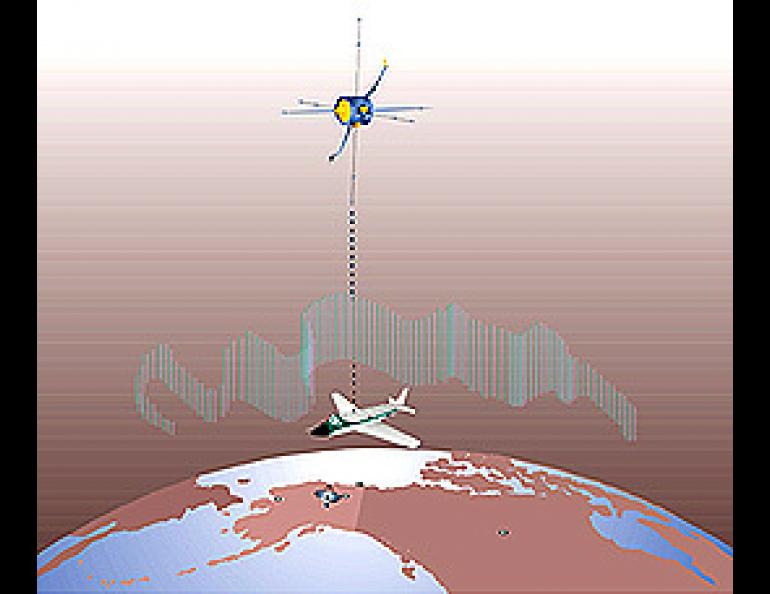
Hunting Down the Elusive Aurora
Sometimes studying the aurora is like hunting moose. You know your quarry is out there, but you don't know its size, or exactly when or where it will appear. You can wait for your target to bump into you, or you can stalk. Several Geophysical Institute scientists chose the latter approach recently, and it worked; if they were moose hunters they would be wrapping steaks right about now.
In their pursuit, the aurora researchers took off in a small jet from Fairbanks every night for two weeks. They did their work around new moon, when the moon's position between Earth and the sun didn't allow a bright moon to interfere with their aurora chasing. On a typical night, Hans Neilsen, the project leader and a professor of physics at the Geophysical Institute, and Daniel Osborne, the project engineer, would locate the aurora on TV monitors within the jet. The TV screens beamed images from three cameras mounted on top of the jet: two narrow-field cameras and an all-sky camera, which gives a view similar to a fish-eye lens.
When they found the aurora, the researchers told the pilot to get them underneath it--at a point where the aurora appears directly overhead--as fast as possible. Their goal was to be beneath the aurora while a satellite designed to sample aurora particles passed above.The satellite, about the size of a washing machine, orbits Earth in an egg-shaped path once every two-and-one-half hours. Flying through space at an altitude of about 2,600 miles, the satellite samples a stream of electron and proton particles before they strike gas atoms and molecules in Earth's outer atmosphere. Once struck by the particles, the gas atoms and molecules become visible as the aurora.
While scientists have studied the aurora with ground-based cameras for years, the chances of having a satellite orbiting overhead at the same instant the aurora occurred directly above the camera are about the same as a hunter seeing a bull moose in his backyard during hunting season. In this experiment, scientists cut the odds by using the jet as a moving camera platform they could position directly beneath the aurora and the satellite.
By circling in a jet beneath the aurora, scientists were able to see much more detail, which they can compare to the data from the satellite. Physicist Tom Hallinan says the view from beneath the aurora is similar to laying down on a theater stage and looking up at several layers of curtains. The audience would only be able to see one layer, but the person directly underneath the curtains could distinguish each set.
From the jet's vantage point under the curtains, the researchers videotaped the aurora from the plane's altitude of about six miles at the same time the satellite sampled at 2,600 miles the particles that cause the aurora. The aurora flickered in the ionosphere between the two from about 60 miles to 300 miles above the ground.
As the researchers viewed the aurora tapes on afternoons following the nightly missions, they observed the hit-and-miss nature of any hunting excursion. On some nights, the aurora was weak when the satellite passed overhead and they were positioned beneath. On others, a wideband of aurora streaked across the TV screen. One night, they caught the elusive black aurora on video at the same time the satellite was streaking above. Black aurora, the lack of activity where it seems like aurora should be, appears on the film like giant black amoebas floating through a sea of aurora. Aurora researchers have long debated whether black aurora is caused by electrons moving in the opposite direction of particles that cause the visible aurora. After Neilsen, Hallinan and graduate student Laura Peticolas sift through the data, that particular question about black aurora may be solved. The experiment will also help scientists figure out why the aurora appears in different forms--a moving curtain at one time, a pulsating blob at another.





